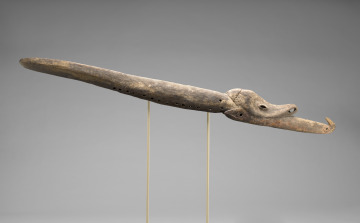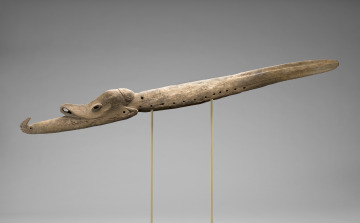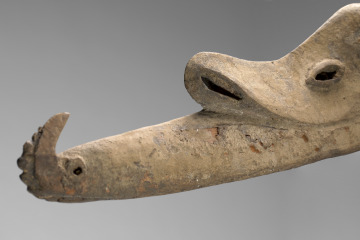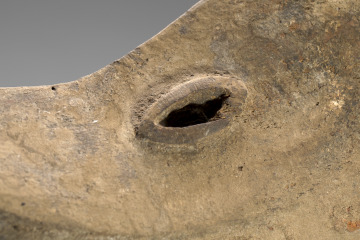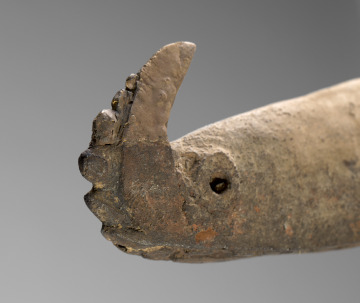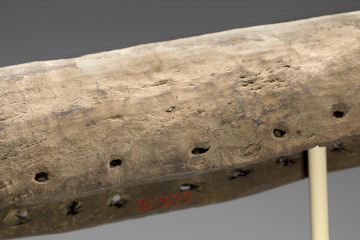Crest Mask
- Culture
- Iatmul artist
- Date
- late 19th to early 20th century
- Material
- Wood, pigment
- Classification
- Costume & clothing, masks
- Collection
- Arts of Africa, Oceania, and the Americas
- Current Location
- On View, Gallery 107
- Dimensions
- 4 5/16 x 6 7/8 x 64 9/16 in. (11 x 17.5 x 164 cm)
- Credit Line
- Gift of Morton D. May
- Rights
- Public Domain
- Object Number
- 32:1977
NOTES
The simple, elongated shape of this mask evokes the body of a fish or crocodile. However, a human face appears at one end. This duality of animal and human elements is essential in the Iatmul worldview. It suggests the ability of ancestors to transform and appear in many manifestations. Young Iatmul men wore masks such as this, horizontally atop their heads, during the first stage of initiation. The pierced holes along the bottom served to affix a covering of plant fibers that hid the body of the dancer.
Until colonization, there were several levels or grades of initiation. Initiation rituals introduce each generation of adolescents and young men to the realm of manhood. Imagined as a long gestation culminating in rebirth, a period of seclusion is fundamental to this process. The first phase involves scarification of the body. Thereafter, the initiates gradually learn aspects of men’s knowledge, such as the fabrication of certain tools for hunting, memorization of mythological cycles and ritual chants, and mastery of musical instruments and martial arts. With each level achieved, an initiate gains specific, secret knowledge and increasingly higher status in society. A prestigious ceremony marks the conclusion of initiation. After a period of seclusion, the young initiates reappear, adorned and resplendent. From this moment, they may access the men’s house.
Provenance
1967 - 1972
Roberta M. Nochimson, New York, NY, USA, collected in Timbunke village, Papua New Guinea [1]
1972 - 1977
Morton D. May (1914-1983), St. Louis, MO, purchased from Roberta M. Nochimson Associates [2]
1977 -
Saint Louis Art Museum, given by Morton D. May [3]
Notes:
[1] Personal communication between Roberta Nochimson and Michael Gunn, October 11, 1999.
[2] An invoice dated May 20, 1972 from Roberta M. Nochimson Associates to Morton D. May documents the purchase of this object with 31:1977, listed as "507 (2) Tambaran Masks, Timbunki, Middle Sepik" [May Archives, Saint Louis Art Museum].
[3] A letter dated March 1, 1977 from Morton D. May to James N. Wood, director of the Saint Louis Art Museum, includes the offer of this object as part of a larger donation [SLAM document files]. Minutes of the Acquisitions Committee of the Board of Trustees, Saint Louis Art Museum, April 14, 1977.
Roberta M. Nochimson, New York, NY, USA, collected in Timbunke village, Papua New Guinea [1]
1972 - 1977
Morton D. May (1914-1983), St. Louis, MO, purchased from Roberta M. Nochimson Associates [2]
1977 -
Saint Louis Art Museum, given by Morton D. May [3]
Notes:
[1] Personal communication between Roberta Nochimson and Michael Gunn, October 11, 1999.
[2] An invoice dated May 20, 1972 from Roberta M. Nochimson Associates to Morton D. May documents the purchase of this object with 31:1977, listed as "507 (2) Tambaran Masks, Timbunki, Middle Sepik" [May Archives, Saint Louis Art Museum].
[3] A letter dated March 1, 1977 from Morton D. May to James N. Wood, director of the Saint Louis Art Museum, includes the offer of this object as part of a larger donation [SLAM document files]. Minutes of the Acquisitions Committee of the Board of Trustees, Saint Louis Art Museum, April 14, 1977.
We regularly update records, which may be incomplete. If you have additional information, please contact us at provenance@slam.org.
